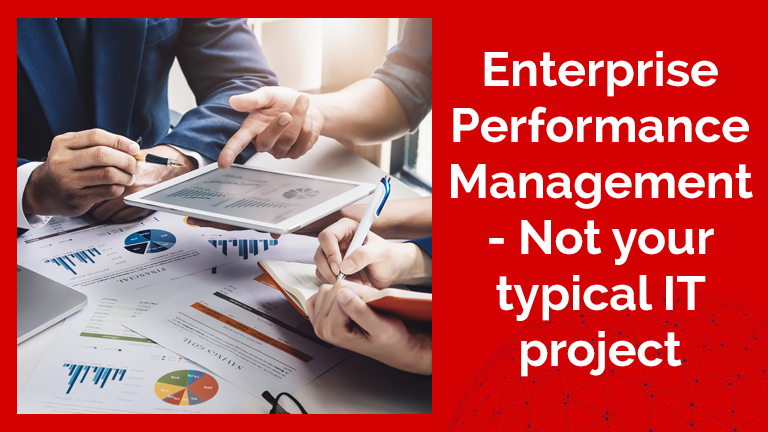Enterprise Performance Management (EPM) – Not your typical IT project
If the IT team is the driving force behind your EPM project, you may want to rethink your approach. Obviously, the role of the IT department is crucially important in an EPM deployment. When software doesn’t function properly, the entire project is in jeopardy and IT will need to fix the technical issues. However, does that mean IT should lead the efforts toward EPM success? EPM is meant to help manage the business, and business unit leaders should be at the forefront. Let’s explore a better approach to EPM deployments and avoid mislabeling it as just another IT project.
Begin with Organizational Strategy
Ideally, EPM discussions begin at the organization’s annual strategic planning session. Once a company hones in on what they want to accomplish, a natural discussion point among senior leaders may be “how their day to day actions will alignâ€. Decisions made on a daily basis need to be driven by a common goal, based on timely and accurate data. Large, high-growth and innovative companies realize how EPM can enable an organization to make better decisions that drive business results. Integration of key platforms can provide meaningful analytics and keep operations efficient. While a good IT and technology approach will certainly support a strategic vision, EPM is more likely to be successful when aligned with a sound business plan.
Executive Sponsorship
Awareness of important differences between an EPM solution and any other kind of finance-related software is key to success. EPM isn’t all about getting numbers faster or better. Instead, it’s about improving an organization’s performance. When that isn’t the focus of the project, problems are likely to surface.
Therefore, an organization must outline a clear charter for its goals from the onset. Executives sponsors should be involved and lead a charter of this magnitude to ensure proper buy-in. This, of course, will require a substantial investment of executives’ time. Thoughtful executive leadership during a significant change event ensures the outcome is aligned with strategy. It also emphasizes the importance to employees, and spreads accountability in the right way. While no one person will ensure EPM success, an executive sponsor sets the tone to establish team commitment.Â
Execution Discipline
Many EPM projects suffer from a lack of rigor required to obtain the primary objectives. Successful EPM projects often adhere to a cadence not typically best managed by IT, since it will enforce accountability of the entire company. That level of responsibility and management is ideally suited for those with action-oriented authority.
Move your EPM project forward with a framework that resonates across departments. Clear, short- and long-term goals, coupled with a measuring tool creates guidance and necessary urgency. These are important in this process, as they won’t allow the project to fall victim to a standard project mindset. Review and identify a project structure adequate for large scale, evolutionary change. The best methodologies will incorporate an engaging process to stay focused for the duration without falling victim to other business distractions.
Place Economic Value on Services
Companies that fail to consider the financial implications of an EPM implementation are making a serious error. An organization should document its project’s ROI from the onset so its financial performance can be adequately measured pre and post adoption. Additionally, a company should determine economic values for all services provided by the software. How will a better budgeting and forecasting cycle improve company performance? What KPI’s will provide the right insights? How does the pace of our decision-making change, and will it advance the organization? This exercise should produce the financial benefits being derived from the implementation from day one.
IT is not always in the best position to determine or measure the metrics that matter most with EPM. Financial expertise and leadership are essential to ensure the investment is maximized. While an EPM platform may use technology to deliver its benefits, it is ultimately a financial and business performance tool.
Leading successful EPM projects is a difficult road, but potential risks can be mitigated by starting with the right level of ownership. IT will play a significant part in EPM success and should be allowed to manage many aspects of the technical responsibilities. However, you will want to consider a primary business unit as the core driver for the project. The end result will likely be better adoption, and alignment with business objectives that are measurable across the company.
